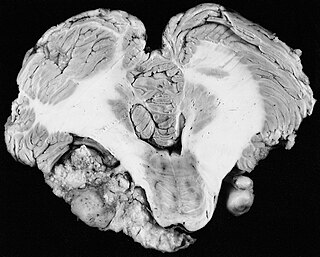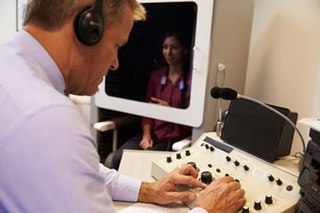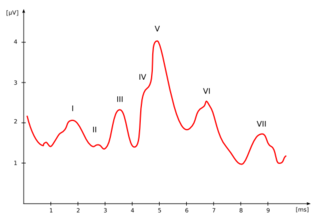
A cochlear implant (CI) is a surgically implanted neuroprosthesis that provides a person who has moderate-to-profound sensorineural hearing loss with sound perception. With the help of therapy, cochlear implants may allow for improved speech understanding in both quiet and noisy environments. A CI bypasses acoustic hearing by direct electrical stimulation of the auditory nerve. Through everyday listening and auditory training, cochlear implants allow both children and adults to learn to interpret those signals as speech and sound.
Bone conduction is the conduction of sound to the inner ear primarily through the bones of the skull, allowing the hearer to perceive audio content even if the ear canal is blocked. Bone conduction transmission occurs constantly as sound waves vibrate bone, specifically the bones in the skull, although it is hard for the average individual to distinguish sound being conveyed through the bone as opposed to the sound being conveyed through the air via the ear canal. Intentional transmission of sound through bone can be used with individuals with normal hearing — as with bone-conduction headphones — or as a treatment option for certain types of hearing impairment. Bones are generally more effective at transmitting lower-frequency sounds compared to higher-frequency sounds.

A vestibular schwannoma (VS), also called acoustic neuroma, is a benign tumor that develops on the vestibulocochlear nerve that passes from the inner ear to the brain. The tumor originates when Schwann cells that form the insulating myelin sheath on the nerve malfunction. Normally, Schwann cells function beneficially to protect the nerves which transmit balance and sound information to the brain. However, sometimes a mutation in the tumor suppressor gene, NF2, located on chromosome 22, results in abnormal production of the cell protein named Merlin, and Schwann cells multiply to form a tumor. The tumor originates mostly on the vestibular division of the nerve rather than the cochlear division, but hearing as well as balance will be affected as the tumor enlarges.

Audiology is a branch of science that studies hearing, balance, and related disorders. Audiologists treat those with hearing loss and proactively prevent related damage. By employing various testing strategies, audiologists aim to determine whether someone has normal sensitivity to sounds. If hearing loss is identified, audiologists determine which portions of hearing are affected, to what degree, and where the lesion causing the hearing loss is found. If an audiologist determines that a hearing loss or vestibular abnormality is present, they will provide recommendations for interventions or rehabilitation.
Unilateral hearing loss (UHL) is a type of hearing impairment where there is normal hearing in one ear and impaired hearing in the other ear.

Otology is a branch of medicine which studies normal, pathological anatomy and physiology of the ear, as well as their diseases, diagnosis and treatment. Otologic surgery generally refers to surgery of the middle ear and mastoid related to chronic otitis media, such as tympanoplasty, or ear drum surgery, ossiculoplasty, or surgery of the hearing bones, and mastoidectomy. Otology also includes surgical treatment of conductive hearing loss, such as stapedectomy surgery for otosclerosis.

Neurofibromatosis type II is a genetic condition that may be inherited or may arise spontaneously, and causes benign tumors of the brain, spinal cord, and peripheral nerves. The types of tumors frequently associated with NF2 include vestibular schwannomas, meningiomas, and ependymomas. The main manifestation of the condition is the development of bilateral benign brain tumors in the nerve sheath of the cranial nerve VIII, which is the "auditory-vestibular nerve" that transmits sensory information from the inner ear to the brain. Besides, other benign brain and spinal tumors occur. Symptoms depend on the presence, localisation and growth of the tumor(s). Many people with this condition also experience vision problems. Neurofibromatosis type II is caused by mutations of the "Merlin" gene, which seems to influence the form and movement of cells. The principal treatments consist of neurosurgical removal of the tumors and surgical treatment of the eye lesions. Historically the underlying disorder has not had any therapy due to the cell function caused by the genetic mutation.

The auditory brainstem response (ABR), also called brainstem evoked response audiometry (BERA) or brainstem auditory evoked potentials (BAEPs) or brainstem auditory evoked responses (BAERs) is an auditory evoked potential extracted from ongoing electrical activity in the brain and recorded via electrodes placed on the scalp. The measured recording is a series of six to seven vertex positive waves of which I through V are evaluated. These waves, labeled with Roman numerals in Jewett and Williston convention, occur in the first 10 milliseconds after onset of an auditory stimulus. The ABR is considered an exogenous response because it is dependent upon external factors.
The Ear Research Foundation, located in Sarasota, Florida, is a center for research and development and medical education. Herbert Silverstein, M.D., is the president and founder of the non-profit corporation.

Cochlear is a medical device company that designs, manufactures, and supplies the Nucleus cochlear implant, the Hybrid electro-acoustic implant and the Baha bone conduction implant.
The cerebellopontine angle syndrome is a distinct neurological syndrome of deficits that can arise due to the closeness of the cerebellopontine angle to specific cranial nerves. Indications include unilateral hearing loss (85%), speech impediments, disequilibrium, tremors or other loss of motor control. The cerebellopontine angle cistern is a subarachnoid cistern formed by the cerebellopontine angle that lies between the cerebellum and the pons. It is filled with cerebrospinal fluid and is a common site for the growth of acoustic neuromas or schwannomas.
An auditory brainstem implant (ABI) is a surgically implanted electronic device that provides a sense of sound to a person who is profoundly deaf, due to retrocochlear hearing impairment. In Europe, ABIs have been used in children and adults, and in patients with neurofibromatosis type II.
Neurotology or neuro-otology is a subspecialty of otolaryngology—head and neck surgery, also known as ENT medicine. Neuro-otology is closely related to otology, clinical neurology and neurosurgery.
Hearing Health Foundation (HHF) is a 501(c)(3) nonprofit organization. In 2011, the Deafness Research Foundation changed its name to Hearing Health Foundation.

William Fouts House was an American otologist, physician and medical researcher who developed and invented the cochlear implant. The cochlear implant is considered to be the first invention to restore not just the sense of hearing, but any of the absent five senses in humans. Dr. House also pioneered approaches to the lateral skull base for removal of tumors, and is considered "the Father of Neurotology".

MED-EL is a global medical technology company specializing in hearing implants and devices. They develop and manufacture products including cochlear implants, middle ear implants and bone conduction systems.
Thomas J. Balkany is an American ear surgeon, otolaryngologist and neurotologist specializing in cochlear implantation.

Dr. Charles Limb is a surgeon, neuroscientist, and musician at the University of California, San Francisco (UCSF) who has carried out research on the neural basis of musical creativity and the impact of cochlear implants on music perception in hearing impaired individuals. As an otologic surgeon and otolaryngologist, he specializes in treatment of ear disorders.
John K. Niparko was an American surgeon, scientist and otolaryngologist who specialized in cochlear implants. Niparko edited and wrote several chapters of Cochlear Implants: Principles & Practices.
Charlotte M. Chiong is a Filipino otolaryngologist with a subspecialty in neurotology, focusing on hearing health, cochlear implants, and neurotological skull base surgery based in Manila, Philippines. She is best known for her research on children's implantable hearing devices, which built the foundation for the Republic Act No. 9709 of the Philippines that organized a universal screening program for hearing loss in newborns.











